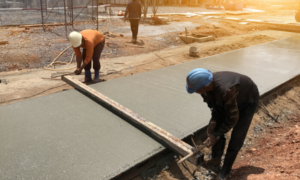Before hiring Concrete Contractors, be sure to look over their references and compare their quotes. A reputable concrete contractor should be able to provide you with at least three references. They should also be able to give you a comprehensive estimate with a fixed cost. It’s also a good idea never to pay the entire balance upfront. This way, you have a buffer in case the construction work is subpar.

In the construction industry, site preparation is an essential component. This includes the demolition of any old structures and clearing any land. It also includes wire mapping, site surveying, layout, and anti-termite treatment. Site preparation is vital for the construction process as it helps identify any potential complications that could impact the project. It also reduces the chance of costly reworks and delays.
Before a concrete contractor can begin work, they must properly prepare the site for construction. Depending on the project, they may use a variety of materials, including metal, concrete, and thermoplastic. These materials are then laid down on a bedding material, backfilled, and leveled. There are two basic types of concrete, including precast concrete and cast-in-place concrete. Both types of concrete require proper compaction.
Site preparation is crucial for a successful project. A good contractor will make sure that a site is clear and has easy access to construction equipment and personnel. A difficult-to-access site can slow down the project and cause difficulties for the construction crew. Proper site preparation will minimize these problems and protect your investment.
Forming with concrete contractors involves the use of a variety of concrete tools. These tools can be used to create a variety of shapes and sizes. The forms are used to hold the concrete in place while it is being poured. Modern farming systems may also incorporate insulation or special decorative effects. Some concrete contractors may use pre-manufactured concrete forms, while others use custom-made designs.
Concrete forms come in a variety of shapes, from basic wood forms to more advanced systems for decorative concrete. For example, if you want to create a curved-radius patio or walkway, forming concrete with plastic forms makes this a simple process. When using these forms, contractors will need to carefully check the shape of the form to avoid overpouring.
Concrete pouring begins once the form is installed and the concrete mixture has been approved. The concrete is then distributed using a hose, truck, or pump. After the concrete is poured, workers will often use industrial vibrating devices to smooth out the surface and remove any air pockets. Alternatively, they may use steam or water to treat the concrete.
The proper placement is critical to the durability, strength, and longevity of a concrete structure. A good concrete contractor knows how to use the proper formula and tools to place concrete exactly where it needs to be. The proper placement is also crucial to avoiding the waste of concrete. When concrete contractors do not follow these guidelines, the results can be negative.
The proper placement is essential to avoid cold joints and weak spots. Concrete contractors must work quickly and correctly to avoid these problems. The temperature at the time of placement must be regulated so that the mix is properly consolidated and compacted. The concrete must also be poured evenly, and any air pockets must be removed. After the concrete has been placed properly, finishing can occur.
Concrete contractors can improve the look of a concrete structure by adding finishing touches. This is important for a variety of reasons, including maintaining the surface’s wear, preventing seepage, and ensuring a smooth, even surface. The finishing process is simple and takes very little time. A good concrete contractor understands your needs and will tailor their services to your project.
There are many different types of finishes for concrete, from a smooth surface to a decorative design. Concrete finishers can use a wide range of tools to achieve this. The most basic finish is a smooth surface, which is achieved by using tools such as trowels and screeds. These tools smooth the surface of the concrete and fill gaps.
Trowels are an important tool for finishing concrete. Both manual and mechanized trowels are used for this process. A manual trowel consists of a flat steel blade with a handle that is pushed across the concrete. Power trowels, which are used for larger projects, have large blades that sit against the concrete. They come in walking and riding models.